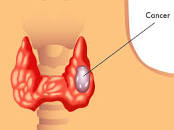“Mukherjee and colleagues sought to determine whether oncologists and hematologists were overtreating with RAI in cases of WDTC, and thus putting their patients at risk for Second Primary Cancers. The answer was a disheartening “yes.“”
Over-diagnosis and over-treatment of cancer is nothing new. Breast and Prostate cancer patients have been struggling with this issue for years. The difference between breast and prostate cancer overtreatment and thyroid cancer overtreatment, according to the article linked and excerpted below, is that overtreating thyroid cancer with Radioactive Iodine (RAI) can cause secondary primary cancers.

In other words, your cancer treatment can give you a different cancer. To add insult to injury, RAI, the therapy that can give you cancer, might not be needed. If your thyroid cancer is early stage, RAI might be overtreatment. Thyroid cancer survivors who undergo RAI therapy and get a second primary cancer, might not have needed the therapy,
I am a long-term cancer survivor who has learned to live an evidence-based, non-toxic, anti-cancer lifestyle through nutrition, supplementation, detoxification, and other anti-cancer lifestyle therapies.
If you would like to learn more about evidence-based therapies to manage thyroid cancer, please scroll down the page, post a question or comment and I will reply ASAP.
Thanks
David Emerson
- Cancer Survivor
- Cancer Coach
- Director PeopleBeatingCancer
Recommended Reading:
“When investigators looked at roughly 150,000 cases of well-differentiated thyroid cancer (WDTC) using the SEER database of the National Cancer Institute, they knew that the use of radioactive iodine (RAI) in conjunction with surgery and other treatments for thyroid cancer had increased dramatically over the years. This was concerning because RAI is a risk factor in second hematologic malignancies (SHMs), and its use is largely unnecessary in many cases of low-risk WDTC according to Sudipto Mukherjee, MD, MPH, an associate staff member of the Department of Hematology and Oncology at Cleveland Clinic in Ohio...
Mukherjee and colleagues sought to determine whether oncologists and hematologists were overtreating with RAI in cases of WDTC, and thus putting their patients at risk for SHMs. The answer was a disheartening “yes…“
Of the 148,215 patients with WDTC, 53% received surgery and 47% received RAI. The RAI treatment was associated with an increased early risk of developing:
- acute myeloid leukemia and
- chronic myeloid leukemia
The increased risk of AML and CML after RAI was seen even in the aftermath of low- and intermediate-risk WDTC tumors, which Mukherjee said would not have been the case had RAI been avoided as a treatment option…
“What we have noticed is that there has been a signal of increased second cancers in these patients. Most of them have involved solid tumors, a few have been hematologic malignancies...
Concerns about second primary malignancies (SPMs) in patients who have been treated successfully for thyroid cancer are reflected in similar trends in other tumor types. In an analysis of the cancer profiles of patients in SEER registries published in JAMA Oncology in November, investigators found that 18.4% of the 765,843 cancers diagnosed in the study population—or 141,021 malignancies—represented a second order or higher primary cancer...
“SUMMARY OF THE STUDY-
A total of 19,068 patients with thyroid cancer were found and 644 of those (3.4%) were found to have secondary cancers…The average age of patients with thyroid cancer was 45 years while the age of patients with secondary cancers was 59 years. The average interval between the two cancers was 6 years.
There was a significant increase in the occurrence of secondary cancers involving the:
- salivary glands,
- nasopharynx,
- thymus,
- female breast,
- bladder,
- brain,
- and for leukemia and lymphoma.
Patients less than 50 years of age were more often diagnosed with leukemia, lymphoma, or bladder cancers. The overall risk of these cancers occurring in patients without thyroid cancer was 2.7%. The survival rate of the 19,068 patients with thyroid cancer was 90%. The median survival was 23 years, but for patients who developed secondary cancers the median survival after the diagnosis of the secondary cancer was only 4.7 years. In general women lived longer than men…”




